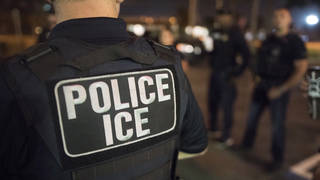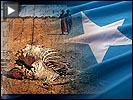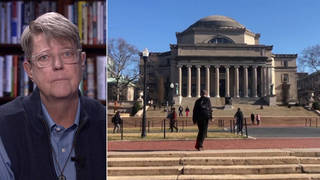
Guests
- Yves van Loospokesperson for International Committee of the Red Cross in Somalia
- Jeremy Scahillnational security correspondent for The Nation magazine and author of the new Nation article, “The CIA’s Secret Sites in Somalia.” He recently returned from Somalia, where he visited camps for residents displaced by the drought. He is the author of the bestselling book Blackwater: The Rise of the World’s Most Powerful Mercenary Army.
U.N. Secretary-General Ban Ki-moon has issued an urgent appeal over the crisis in Somalia, where more than 11 million people are in need of life-saving assistance as they face the worst drought in decades. The United Nations describes the Somali drought as the worst humanitarian disaster in the world, and a top U.N. official, Valerie Amos, urged the world to make the link between climate change and the drought. The extended drought is forcing an estimated 3,000 people a day from Somalia to neighboring Kenya and Ethiopia. We speak to Yves van Loo in Nairobi of the International Committee of the Red Cross in Somalia, who was in Mogadishu just two weeks ago. We also speak to investigative reporter Jeremy Scahill, who recently returned from assignment in Somalia. [includes rush transcript]
Transcript
AMY GOODMAN: We turn now to what’s been characterized as the worst humanitarian disaster in the world: the famine in Somalia and the Horn of Africa. U.N. Secretary-General Ban Ki-moon issued an urgent appeal yesterday to respond to the crisis, where more than 11 million people are in need of life-saving assistance as they face the worst drought in decades. Secretary-General Ban said, quote, “The human cost of this crisis is catastrophic. We cannot afford to wait.”
The extended drought is forcing an estimated 3,000 people a day from Somalia to neighboring Kenya and Ethiopia. U.N. High Commissioner for Refugees, António Guterres, also issued an urgent appeal earlier this week.
ANTÓNIO GUTERRES: I have no doubt that Somalia is today the worst humanitarian disaster that we face in the world. Here in the outskirts of the Somali refugee camp of Dadaab, we have the poorest of the poor, the most vulnerable of the vulnerable in the world.
AMY GOODMAN: For more, we’re joined on the phone by Yves van Loo in Nairobi, Kenya, the spokesperson for the International Committee of the Red Cross in Somalia. He was just in Mogadishu two weeks ago.
Yves, explain the scope of this catastrophe that is unfolding now in Somalia.
YVES VAN LOO: Actually, we get the report from all of the staff still based in Somalia. They’re all speaking about the same, that there is no water, that with the real lack of rain this year, it’s the second agricultural season that is lost for the country. So people are desperately seeking for shelter. They try to escape the drought. They try to escape also the insecurity, because, as you know, Somalia is still facing a war. And people try to avoid to stay too close to the front lines. So we could see, especially in Mogadishu and, as your correspondent mentioned, in neighboring countries like Ethiopia and Kenya, that thousands of people are just gathering to a improvised or structural refugees camp.
AMY GOODMAN: How bad is the famine right now, and what is causing it?
YVES VAN LOO: What we can see, for the ICRC, we are supporting a huge network of therapeutic feeding centers and clinics operated by a partner from the Somalia Red Crescent. What we could see, that for the last three months the admitted children just doubled. We pass—for instance, for this Bay region, in June we got three times more children than the children that were already inside the center. The malnutrition rate just raised up to 11 percent. It is twice the alarm level. So the situation is very, very bad. I mean, it’s a huge effort to be made to feed the population.
AMY GOODMAN: I wanted to get your response to the reports that some aid organizations say relief efforts have been hampered in Somalia due to U.S. anti-terrorism laws that bar any person or organization from providing any type of material support, even humanitarian aid, to groups that have ties to Al Shabab, a designated terrorist organization that controls part of Somalia. Groups like Mercy Corps are saying this. Are you finding this, as well?
YVES VAN LOO: Well, for us, I mean, the way we’re operating, of course, we do not pass through the authorities. What we do with any authority that is in charge or in control of the territory is, of course, to inform them and ask permission to operate. But then, of course, the operation is conducted exclusively by ICRC personnel. So, the assistance that will be provided will be straightly delivered to the beneficiaries. It doesn’t pass through any local structure, any local organization, controlled by any government or any group in charge of a territory.
AMY GOODMAN: Yves van Loo, since you are a spokesperson for the International Committee of the Red Cross in Somalia, in our last segment, we were talking with investigative journalist Jeremy Scahill about the secret prison in Mogadishu and wondering whether the ICRC knows about it and is visiting the prisoners inside?
YVES VAN LOO: No, we are not visiting, and we’re not aware of any secret prison there. What I know is that, of course, in Somalia you have secret services, and you have also foreign intervention, like African Union there. So, of course, we suspect that some of the people there belong to intelligence. But now we do not conduct any activities with them. I saw that—I heard your correspondent refer to the arrest and the transfer of Mr. Warsame. But so far, I mean, we—yeah, we’ve been notified by the Department of State, but yeah, we do not have any detention activities so far in Somalia.
AMY GOODMAN: Jeremy Scahill?
JEREMY SCAHILL: Yeah, I’m happy to provide you with the location of the secret prison. Just go to where President Sheikh Sharif’s office is, and it’s right behind it in the basement of Somalia’s National Security Agency. And I think that the Red Cross should demand immediate access to this prison from both the United States government and the Somalia Transitional Federal Government, because, according to former prisoners, lawyers and Somali intelligence officials, there are scores of people that have been held without charge in this basement, some of them, as far as we can document, for more than 18 months. And the Red Cross should be insisting on access to this prison, which is actually within the TFG’s, the Somali government’s compound in Villa Somalia.
YVES VAN LOO: OK. So, just thank you for the information. What I suggest is maybe offline that you give me your contact. Then we can speak further on this matter. But I think—I mean, with no information from my side, it’s difficult to make any comment on that. But that’s very interesting.
AMY GOODMAN: Jeremy Scahill, you were also in the camps. Can you talk about the effect of the famine and what you saw? You are just back also from Somalia.
JEREMY SCAHILL: Yeah, I mean, we also traveled down to the Kenya-Somalia border, and it is the largest refugee camp in the world at Dadaab, and—the one operated by the United Nations. It was originally built in 1991 for about 90,000 people. There are now almost 400,000 people that are in that camp. And then there are tens of thousands of others who have set up their own ad hoc housing outside of the camp and are hoping to make their way into the camp. I mean, it’s an utterly horrifying situation.
And part of what’s happening is that there is a Somalia crisis industry that is profiting from this, largely based in Nairobi, people with large salaries and maids and nannies, living in nice apartments in Nairobi, that never step foot anywhere inside of Mogadishu, except within the protected confines of the African Union or U.N. presence there near the airport. And, I mean, we were in the only trauma hospital in Mogadishu, and they said there are—they have four surgeons there. They get a lot of support from the Red Cross, but only in supplies. There are no—there is no international presence that can be seen, whatsoever, in the vast majority of Mogadishu, and that is a part of the problem.
And, you know, the Shabab areas are the most desperately affected in terms of the civilian consequences of what we saw, and that was an indiscriminate shelling by the African Union forces, armed and backed by the United States, launching missiles from their base miles away from Bakara Market, randomly just hitting buildings there. We saw bodies buried, decapitations that had happened, communities that reeked of rotting human flesh, wastelands where animals roam eating trash. And there’s nothing. There’s no one there. There are no doctors in the Shabab-controlled area. One doctor that we talked to was kidnapped by the Shabab and taken to their area to train nurses. And he told us, “I would have gone there if they had asked me, but they snatched me off the streets and took me there and forced me to train nurses.” What’s desperately needed is someone to stand up and say, “We will take the risk to go in there and bring humanitarian aid, regardless of what governments tell us not to do it.”
AMY GOODMAN: Yves van Loo, spokesperson for the International Committee of the Red Cross, we just got this news from Al Jazeera English. “The UN World Food Programme would welcome any assistance from the hardline Muslim group al-Shabab to help avert a humanitarian disaster in the Horn of Africa, a spokesman [has] told Al Jazeera.
“Al-Shabab has [already] lifted a ban on humanitarian agencies supplying food aid to millions of citizens [amid] one of the region’s worst droughts in 60 years.”
How significant is this? And what are you calling for the world to do now for and with Somalia?
YVES VAN LOO: What is clear is that the Somali population has been suffering for the last 20 years. You know, it’s the political instability, this war. They have drought and flooding. So, of course, any organization that is coming to the country will be welcome to support the existing organizations already working in the country. The needs are huge. I mean, it’s difficult really to give figures because, you know—because of insecurity, it’s very difficult to conduct large assessments.
I wanted also to react to what your correspondent just stated about doctors. I mentioned in the beginning of my intervention that we are supporting also a network of clinics from the Somalia Red Crescent and some hospital. And actually, there are some doctors also in the Al Shabab-controlled areas. And we support also those facilities.
AMY GOODMAN: And on your last point, the Shabab says they will allow the food through and the humanitarian groups to operate.
YVES VAN LOO: Yeah, it’s good things. I mean, it’s a bit—the point is that, I guess, that, like the ICRC, most of the organizations will decide what is the most appropriate program to support the Somali population.
AMY GOODMAN: Well, I want to thank you, Yves van Loo, spokesperson for the International Committee of the Red Cross in Somalia, just back from Mogadishu, speaking to us from Nairobi, Kenya. And Jeremy Scahill, who has an exposé in this week’s Nation magazine called, national security correspondent for The Nation. It’s called “The CIA’s Secret Sites in Somalia.” Jeremy Scahill also a Democracy Now! correspondent. Thanks. I look forward to your next report, Jeremy, and we’ll link to The Nation for this one.












Media Options